Why Two-Face Is Batman's Second Greatest Villain
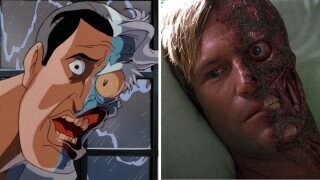
For over 80 years, Batman has evolved and changed while still being one of the biggest forces in pop culture. This week, Cracked is doing a deep dive into the Dark Knight.
We're giving away four pieces of art from legendary Batman creatives Alex Ross and Frank Miller courtesy of our friends at The Haul. Enter your email below for a chance to win and learn more here.
Don't Miss
Two-Face is easily Batman's most notable non-clown villain, having appeared in multiple movies, TV shows, video games, giant-headed plastic figure atrocities, and even a popular song by David Bowie (that one that goes "Your face, Two-Face, with the man who sold the world ..."). What is it that makes Harvey Dent such a good/bad antagonist? Given today is 2/22/22, there's no better time to look back at his history and find out (unless you're willing to wait 200 years; check back for an updated version then!).
Early Batman Comics And Shows Mostly Ignored Him (Because He Freaked Everyone Out)
Two-Face was introduced in 1942's Detective Comics #66 as "the most bizarre criminal of all time ... a 20th-century Jekyll-Hyde." Bob Kane, Batman's (let's be generous here) co-creator, claimed he got his inspiration from Dr. Jekyll and Mr. Hyde. However, Two-Face's origin is also suspiciously similar to a pulp character from a few years earlier, the Black Bat: both are successful District Attorneys who get acid thrown at their faces by criminals during a trial, except Two-Face skipped the part about getting an eye transplant from a murdered police officer and gaining super-sight.
In this version, formerly handsome D.A. Harvey "Apollo" Kent only becomes criminally insane when some insensitive passers-by and his own girlfriend react poorly to his half-hideous mug.
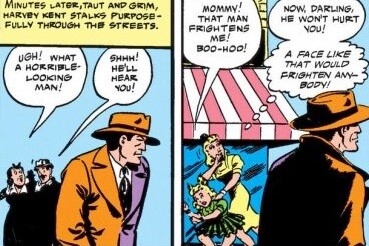
DC Comics
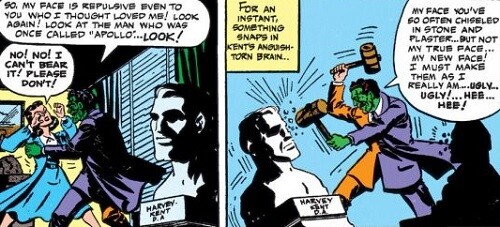
DC Comics
But, after only three appearances, the power of love and Batman's friendship convince Two-Face to abandon his promising criminal career -- he even helps Batman round up the members of his gang (who really should have seen the double-cross coming).
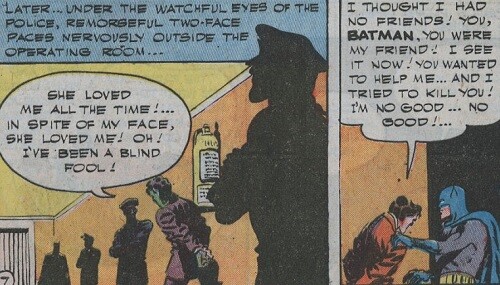
DC Comics
After getting plastic surgery, Harvey fully recovers and goes back to practicing law. The only "Two-Face" appearances for the next decade were fake-outs. There were two Two-Face impostors (one of whom disguised the wrong side of his face because he'd only seen Harvey in pictures) and an actor who went through the exact same accident while shooting a biopic, but he's also cured by the end of the story. The Batman comic strip introduced a different Two-Face, but he slips on his scarred coin and dies at the end of his first story. It's like the writers were unwilling to accept the possibility of a good guy being permanently corrupted because that was just too messed up for a children's comic.
Two-Face came back for real in 1954 when poor Harvey Dent tried to stop some thieves and was caught in an explosion that instantly "undoes" his plastic surgery and psychological progress.
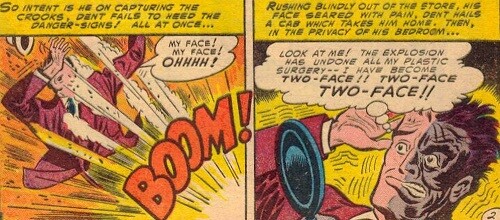
DC Comics
This time, Batman doesn't even try to cure him and just throws him in jail for the next two decades. In the meantime, there were two separate attempts to bring Two-Face as a baddie for Adam West to SMACK! and POW! in the 1966 Batman show, but he was reportedly considered "too gruesome and violent" for the kids at home. That's probably the same reason why he was completely snubbed by all of the Batman and Super Friends cartoons -- even the Scarecrow was invited into the Legion of Doom, and he's got "scare" in his name.
Two-Face busted out of prison in the early '70s, when DC finally went back to writing Batman like the average reader wasn't 8, and it was only then that Harvey started showing up with any regularity. It's impressive that the character became such an iconic Bat-villain with only a handful of comic appearances and exactly zero media adaptations across his first three decades. A big part of that is due to the fact that ...
He's Got The Best Gimmick Of Any Bat-Villain
Two-Face's scarred coin was right there in his first appearance, although it was originally a piece of evidence against the criminal who threw acid at his face.
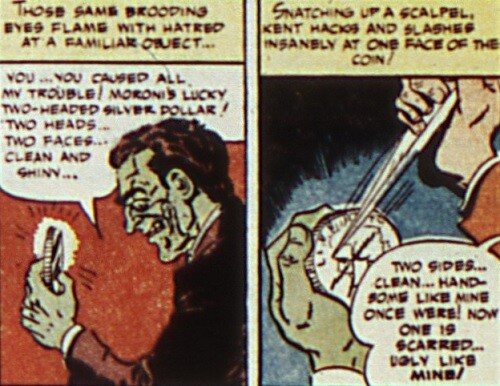
DC Comics
Harvey scratches the coin and flips it to decide if he'll become a criminal or go to a plastic surgeon, and so was born one of the best gimmicks in comics. In keeping with his new theme, he gets a hideout that's half pristine and half trashed and uses the coin to decide if he'll do good or bad deeds. A lot of people in Gotham are like, "Sure, he murdered some people, but he also gave me money, so who's to say if he's good or bad?

DC Comics
In the same issue, Harvey feels pretty clever for basing his crime spree on the number two, which no one will ever figure out (he hijacks a two-decker bus, robs a double-feature cinema, etc.). This obsession with twos and flipping coins would grow more ridiculous over the years -- at one point, he straps Batman and Robin to a giant penny and flips it over some spikes. His crimes would range from robbing a two-masted ship to stealing the binary codes for nuclear weapons and using them to blackmail the government for $22 million dollars. He could spend months planning out a heist only for his coin to land on the unmarked side at the end and force him to give up to Batman.

DC Comics
But, as the character entered the modern age, the reasons behind his compulsion would grow more complex. In 1990's Batman Annual #14, it's revealed that Harvey's father was abusive and would flip a coin promising he wouldn't beat him if it landed on tails. Too bad it was a double-headed coin. Harvey represses his resulting anger issues for decades, repeating to himself that he's a "good boy," but then his accident makes him feel like he "can't hide" who he is anymore.
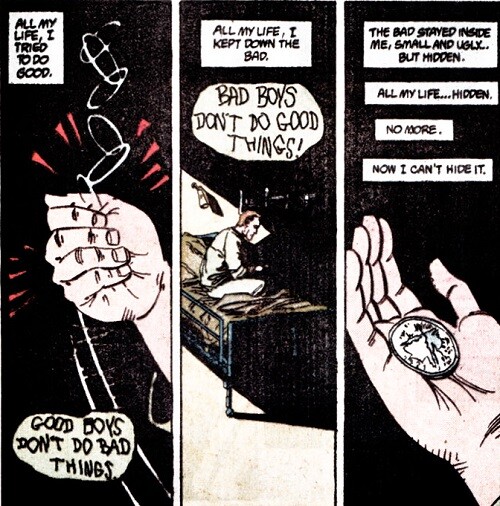
DC Comics
In the 1989 Arkham Asylum graphic novel, Harvey's doctors take away his coin and replace it with a die, then a pack of Tarot cards, and eventually the I Ching to gradually cure his reliance on black and white absolutes. Unfortunately, this just makes it so he can't even go take a piss without consulting his cards. Later, trapped by the insane logic of Arkham's inmates, Batman proposes giving Harvey his coin back and letting him decide if they kill him or let him go. Harvey flips it and announces that Batman goes free, but later we see that the coin landed on the scarred side. Harvey himself decided to let his old friend go.
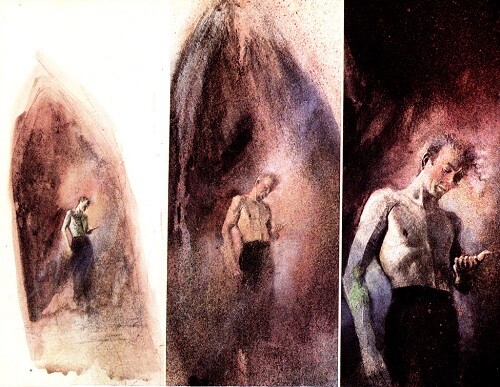
DC Comics
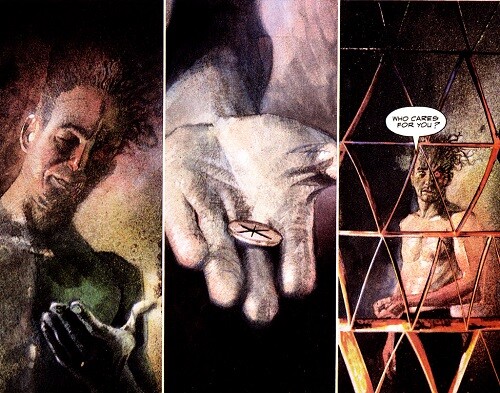
DC Comics
So not only was Two-Face's gimmick fun in the old comics, but it actually withstood a more serious interpretation without coming off as awkward or forced. Unlike, say, trying to convince us the Riddler is obsessed with riddles because he choked on a Bazooka Joe gum as a kid (potential The Batman spoilers). This successful transition into the modern era also explains why ...
He Works Exceedingly Well In Adaptations
After being ignored by Batman-related media for many years, Harvey made his film debut in Tim Burton's 1989 movie, where Billy Dee Williams plays him as a popular D.A. who will surely always be Batman's good buddy and ally. Of course, Burton was setting up Harvey's transformation in a future movie until the sudden intrusion of Joel Schumacher and Tommy Lee Jones' "Joker 2" version of Two-Face ruined it. What should have been the emotional center of the film became a 20-second news clip.
We were denied the character arc Harvey deserved ... in those movies, anyway. At the same time, Batman: The Animated Series gave us one of the finest versions of the character on any medium by actually taking the time to introduce Harvey as a good guy and close friend of Bruce Wayne before he turns to villainy. Like the modern comics, the show also made it clear that Harvey's mental issues didn't exactly come out of a bottle of acid (or an explosion, in this case).
One of BTAS' strengths is that it didn't just faithfully adapt the characters -- in some cases, they improved them and made the comics take notes. Two-Face is a good example because the writers took the character to his logical extension by giving him another personality that was obsessed with justice and order to balance out Two-Face's lawlessness and chaos.

Warner Bros. Animation
Christopher Nolan's The Dark Knight followed BTAS' example by taking its sweet time developing Harvey as a good guy and setting up the psychological reasons for his fall before it happened. This serves as an excuse for a powerful performance by Aaron Eckhart and the movie's CGI wizards ...
... which, of course, is still not as powerful as William Shatner's vocal portrayal in the 2017 Batman vs. Two-Face animated movie with Adam West.
Okay, so the Shat may have laid it on a little too thick there (a rarity for the actor), but this movie at least proved that Harvey would have worked just fine in the Adam West-verse.
Part of the reason why Two-Face works so well in adaptations is that he's sort of like the Anti-Batman: he started as a defender of the law, but a tragic encounter with a criminal changed the direction of his life. He's an interesting character by himself, but even more so when used as a contrast to the hero. It seems almost inevitable that HBO Max will make Harvey the center of one of the 200 or so Batman-related shows they're planning, but his story probably won't have the emotional resonance of BTAS or TDK without Batman (or at least Bruce Wayne) present. Give us a Batmite show instead, cowards.
Follow Maxwell Yezpitelok's heroic effort to read and comment on every '90s Superman comic at Superman86to99.tumblr.com.
Top image: Warner Bros. Pictures, Warner Bros. Interactive Entertainment
